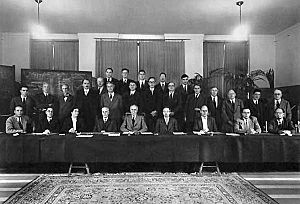Yvette Cauchois facts for kids
Quick facts for kids
Professor
Yvette Cauchois
|
|
|---|---|
| Born | 19 December 1908 Paris, France
|
| Died | 19 November 1999 (aged 90) Paris
|
| Resting place | Monastery Bârsana, Romania |
| Nationality | French |
| Education | Sorbonne |
| Known for | Inventing the Cauchois spectrometer Development and use of Synchrotron light President of the French Society of Physical Chemistry |
| Awards | Ancel Prize from the Société chimique de France (1933) Officer of the Legion of Honour |
| Scientific career | |
| Fields | X-ray spectroscopy X-ray optics |
| Institutions | CNRS National Laboratories of Frascati |
| Thesis | Extension de la spectroscopie des rayons X. Spectrographe à focalisation par cristal courbé; spectre d'émission X des gaz (1934) |
| Influenced | Christiane Bonnelle |
Yvette Cauchois (born December 19, 1908 – died November 19, 1999) was a brilliant French physicist. She was famous for her work with x-ray spectroscopy and x-ray optics. She also led the way in synchrotron research in Europe.
Contents
Becoming a Scientist
Yvette Cauchois went to school in Paris, France. She studied physics at the Sorbonne. In July 1928, she earned her degree in physical sciences.
She continued her studies at the Laboratory of Physical Chemistry. In 1933, she earned her doctorate degree. Her research was about using curved crystals to study x-rays in great detail.
Her Career in Science
After getting her doctorate, Yvette Cauchois became a research assistant. She worked at the CNRS. In 1937, she was promoted to research associate. That same year, she helped open the Palais de la Découverte, a science museum.
In 1938, she became the head of the Physical Chemistry Laboratory in Paris. During World War II, many scientists had to leave. Yvette Cauchois kept the laboratory running. She became a Professor at the Sorbonne in 1945. In 1954, she became the head of Chemical Physics.
As her team grew, they needed more space. So, in 1960, she started a new center. It was called the Centre de Chimie Physique in Orsay. She managed this center for ten years. At the same time, she continued her work at the Sorbonne.
From 1975 to 1978, Yvette Cauchois led the French Society of Physical Chemistry. She was only the second woman to do this, after Marie Curie. She retired in 1983, but she kept doing research. Even at 83 years old in 1992, she was still active in the lab! She wrote over 200 scientific papers.
X-rays and Crystals Research
In the early 1930s, Yvette Cauchois created a new type of x-ray spectrometer. This machine was easy to use and could see very fine details. It was named the Cauchois spectrometer after her.
Starting in 1934, she used it to study gases and their x-ray emissions. Her new method was used worldwide. It helped scientists analyze x-rays and gamma rays. This led to many new studies in radiation.
She also found a way to focus x-ray radiation. She used curved crystals for this. This helped create better monochromators and tools for x-ray scattering. Her work helped scientists understand how materials absorb x-rays. She used reflected radiation to study the inside of materials.
Yvette Cauchois carefully studied the x-ray patterns of heavy elements and actinides. In 1936, she and Horia Hulubei thought they had found a new element, element 85. They published more research on it in 1939. She also studied polonium and neptunium. Later, she was a pioneer in studying transuranic elements.
She was also very interested in space. She studied x-ray radiation from outside Earth. She focused on the solar x-ray spectrum using rocket experiments. In 1970, she even took x-ray pictures of the sun!
Synchrotron and Solar Research
Starting in 1962, Yvette Cauchois began a new research project. She worked with a group in Italy. They wanted to explore synchrotron research. She was the first person in Europe to see how useful synchrotron radiation could be. This radiation comes from electrons moving in a special circle. It helps scientists understand how matter works. In the early 1970s, she did her experiments at LURE in France.
Her Life Outside Work
Yvette Cauchois cared a lot about helping young people. She also loved poetry and music. She was a very good piano player.
Later in her life, she became interested in the Orthodox religion. In 1999, at 90 years old, she traveled to Maramures, Romania. She was baptized there. Sadly, she got sick on this trip. She died a few days after returning to Paris. She was buried in the Monastery Bârsana in Romania.
Awards and Recognition
Yvette Cauchois received many awards for her amazing work:
- Ancel Prize from the Société chimique de France (1933)
- Henri Becquerel Prize from the French Academy of Sciences (1935)
- Gizbal-Baral Prize from the French Academy of Sciences (1936)
- Jerome Ponti Prize from the French Academy of Sciences (1942)
- Triossi Prize from the French Academy of Sciences (1946)
- Officer of the Legion of Honour
- Officer of the National Order of Merit (France)
- Medal of the Czechoslovak Society of Spectroscopy (1974)
- Fellow of The Optical Society (1974)
- Gold medal of the University of Paris (1987)
- Doctor honoris causa (an honorary degree) from the University of Bucharest (1993)
Her name was also given to streets in Gif-sur-Yvette and Tomblaine.
See also
 In Spanish: Yvette Cauchois para niños
In Spanish: Yvette Cauchois para niños


